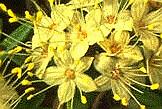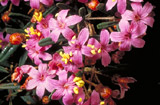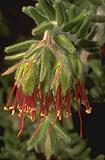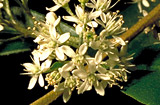|
[Front Page] [Features] [Departments] [Society Home] [Subscribe]

Poor Relations
Brian Walters
Phebalium/Leionema/Nematolepis
There are many beautiful and spectacular members in the Boronia group of plants. Apart from the genus Boronia itself, numerous species and cultivars of Crowea, Eriostemon and Philotheca are widely represented in the stock of specialist Australian native plant nurseries. Some can even be found in general nurseries.
This Boronia group of plants are members of the plant family Rutaceae, a family which is widely distributed throughout the world and which includes the commercially important citrus plants....lemon, orange, grapefruit, etc.
Apart from the commonly cultivated members of the family, the Boronia group includes many other attractive species which are deserving of wider cultivation. Not least of these are species in what I've termed the "Phebalium group" - Phebalium, Leionema and Nematolepis. With the exception of forest phebalium (Phebalium squamulosum) and perhaps Leionema lamprophyllum, it's extremely rare to find members of this group available through general garden centres. Even among Australian plant enthusiasts the group is poorly represented in native gardens.
It's about time that this changed!!!!
Before looking at some of these very desirable plants, a quick word of explanation as to why I've grouped these three genera together......
Recent revision has resulted in botanical reclassification of these plants. Previously most of these plants were classified in the genus Phebalium but the revision has resulted in the transfer of 21 species formerly in Phebalium to the new genus Leionema. Six other Phebalium species have been transferred to Nematolepis, a genus which previously contained only a single species. The reclassification will take some getting used to but the plants are still the same plants, regardless of how botanists classify them!
Unfortunately there are few common names for this group so, for the most part, we'll just have to struggle through with the botanical names!
Typically, this group displays starry-shaped, 5-petalled flowers, often in clusters and generally white, cream and yellow in colour. This arrangement is shown by the accompanying photo of Phebalium squamulosum, a very popular plant in cultivation and hardy in a range of climates and soils. But there are exceptions....Look at Phebalium nottii. It has the typical starry shape of this group but the deep pink colour is unusual and is shared by only one or two other members of the group. Unfortunately this particular species has not adapted well to cultivation, although grafting it on to the hardy P.squamulosum may improve its longevity.
 |
|
Phebalium squamulosum (top) shows the typical starry flower clusters of this group of plants.
The pink flowers of Phebalium nottii (bottom), however, are unusual in a group dominated by white and yellow colours.
Select the thumbnail image or highlighted name for a higher resolution image (40k and 36k).
|
 |
A bit different are the few species with pendant, elongated flowers and protruding stamens - take a look at L.carruthersii and L.viridiflorum. Can these really be in the same group as forest phebalium. Yes indeed, but these are true oddities - few people have seen them growing naturally in the bush and it would be very unusual to see them in cultivation outside of botanic gardens. Both of these species are "at risk" in the wild. L.carruthersii is found only on the south coast of New South Wales near Moruya while L.viridiflorum is restricted to the Warrumbungle ranges in north-western New South Wales. One or two other species share this flower arrangement (eg. L.ralstonii).
 |
 |
Leionema viridiflorum (left) and Leionema carruthersii (right) both display elongated flowers which are unusual in this group of plants.
Select the thumbnail image or highlighted name for a higher resolution image (28k and 31k).
|
Cultivation potential
P.squamulosum has proven adaptable in a range of soils and climates but what of the others? About a dozen or so have been grown by enthusiasts with varying degrees of success.....
- L.ambiens - reasonably hardy shrub to 2.5 metres with unusual stem-clasping foliage and white flowers.
- P."Bundaberg" - a plant of uncertain origin which may be a form of P.woombye or a hybrid. It is not unlike P.nottii in appearance although the flowers are a paler pink and the plant is much hardier. Tolerant of dry soils but flowers best when water is available.
- P.dentatum - graceful shrub to 2.5 metres which appears to be very hardy in temperate climates. It produces a massed display of pale yellow flowers. An outstanding but extremely under-rated species worthy of widespread cultivation.
- L.elatius - not well known but subspecies beckleri appears to be very hardy in temperate climates. It grows to about 2 metres and has white flower clusters. Another one worthy of widespread cultivation.
- P.glandulosum - reasonably hardy in a very well drained sunny position. It has small, serrated leaves and brilliant yellow flowers on a shrub to 1 metre. A little stunner!!
- L.gracile - shrub to about 1 metre. It has clusters of small, white flowers.
- L.lamprophyllum - a small shrub to about 1 metre with small, glossy green leaves and masses of white flowers. Fairly readily available and very hardy.
- Leionema phylicifolium - Small shrub to 1 metre with narrow leaves and masses of cream flowers. Native to high altitude and can be difficult to maintain. Worth the effort!
- L.rotundifolium - reasonably hardy. It has clusters of yellow flowers on a shrub to about 2 metres.
- Nematolepis squamea - very hardy in temperate climates. It has large oval-shaped leaves which are glossy green above and silvery below - looks fantastic in a breeze!! It can reach 2-3 metres or more and has clusters of white flowers.
- P.woombye - reasonably hardy with white and pink-flowering forms. It is normally a shrub to 1 metre but a prostrate form is in cultivation.
As a general rule, most members of the Phebalium group prefer well drained, slightly acid soils with some protection from full sun, but not heavy shade. Once established they can usually survive quite well without artificial watering. They are not demanding of fertilizer - a small amount of slow release fertiliser when they are planted will give them a good start. Additional fertilising can be applied annually after flowering but is rarely necessary.
 |
Nematolepis squamea is a large shrub or small tree. It was previously known as Phebalium squameum.
Select the thumbnail image or highlighted name for a higher resolution image (31k).
|
This is a group of plants with much to offer - keep your eyes open at the next Society plant sale and you might find one or two to take home.

[Front Page] [Features] [Departments] [Society Home] [Subscribe]
Australian Plants online - December 2000
Association of Societies for Growing Australian Plants
|